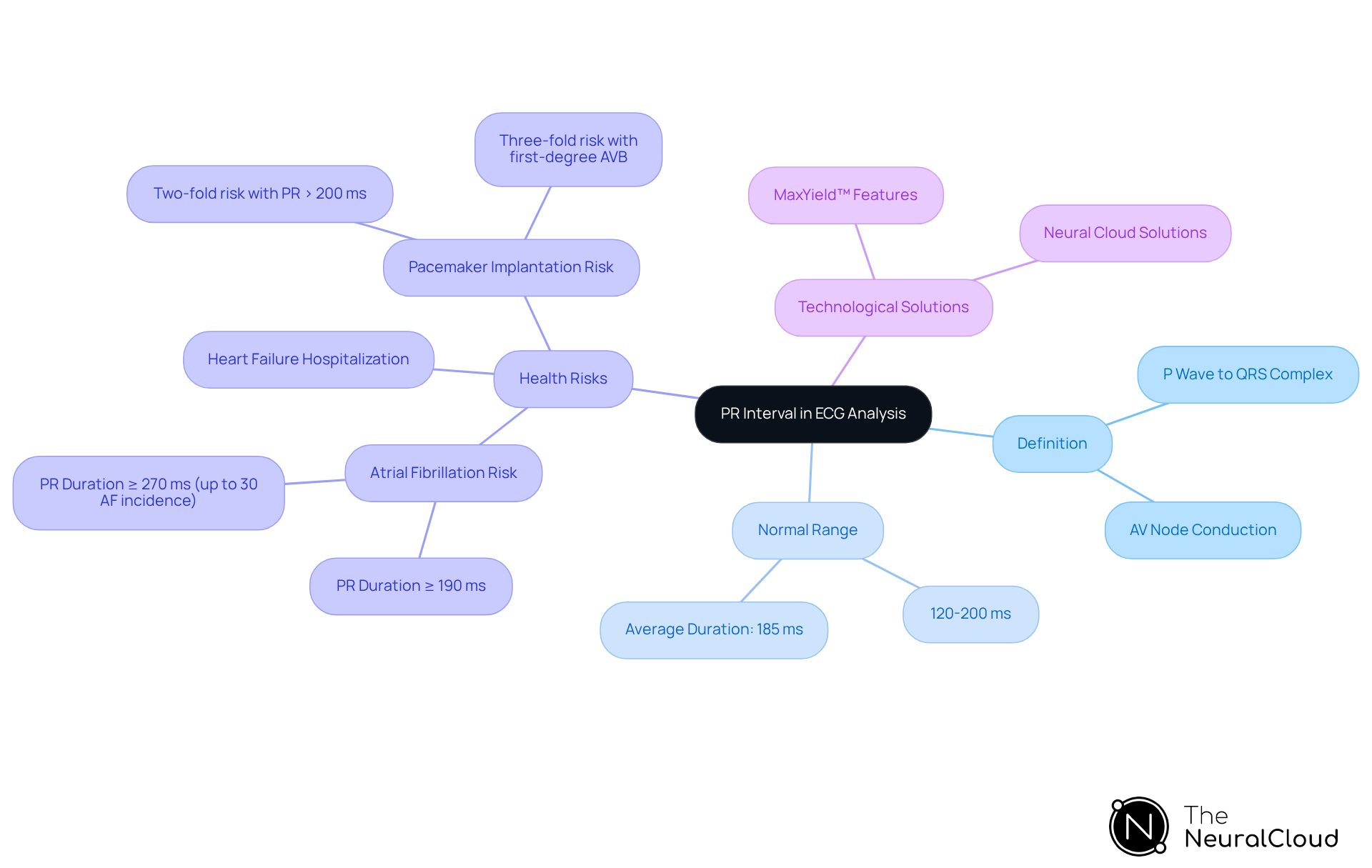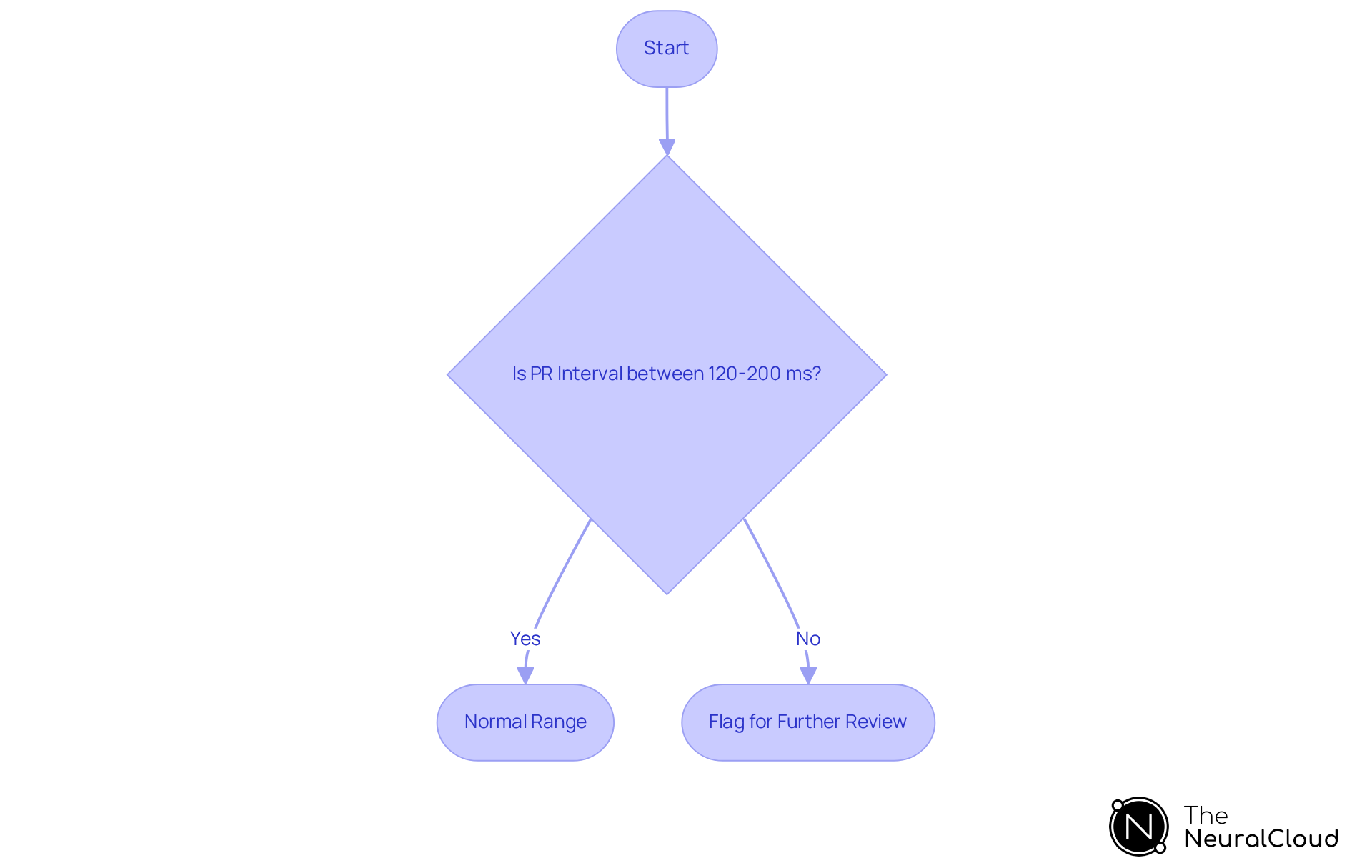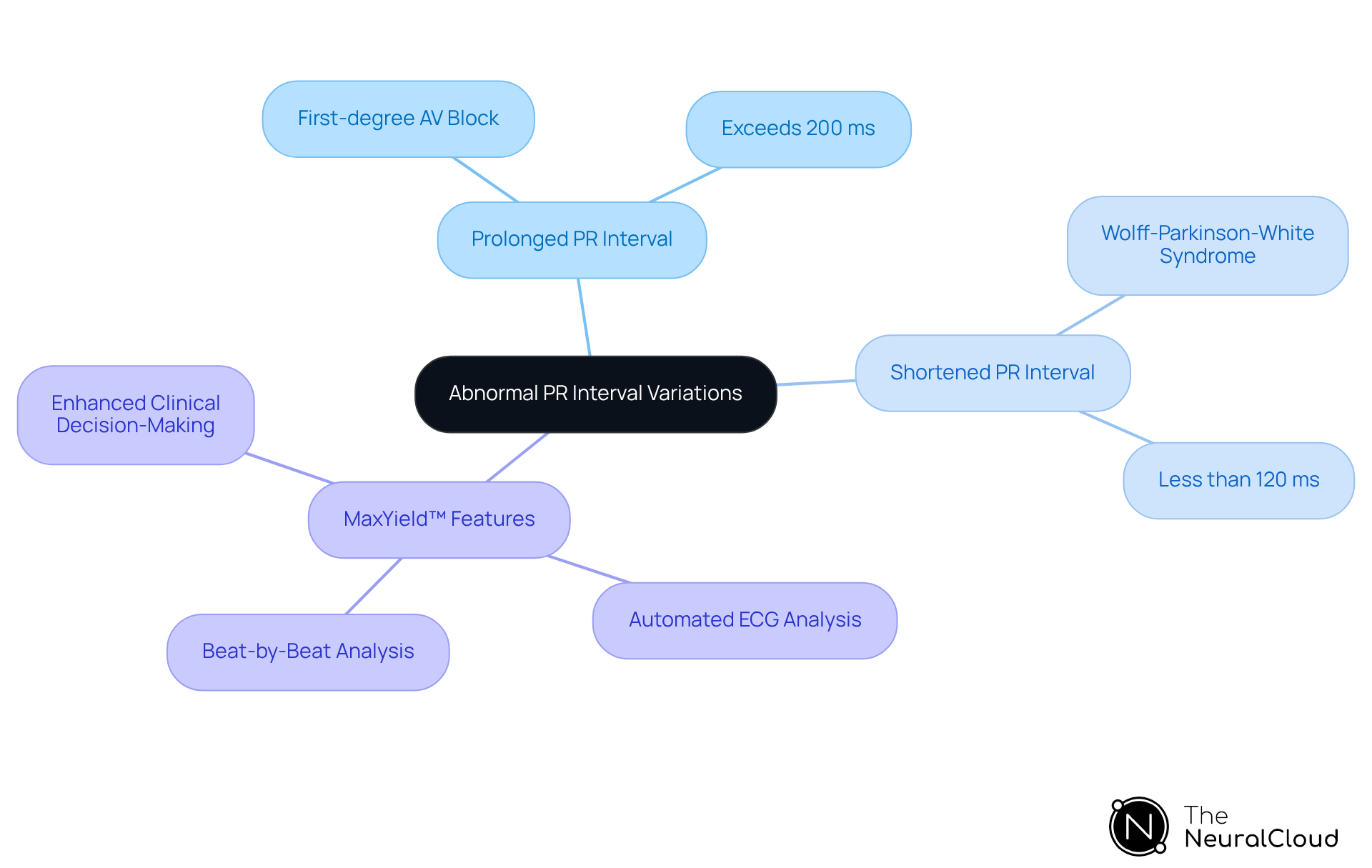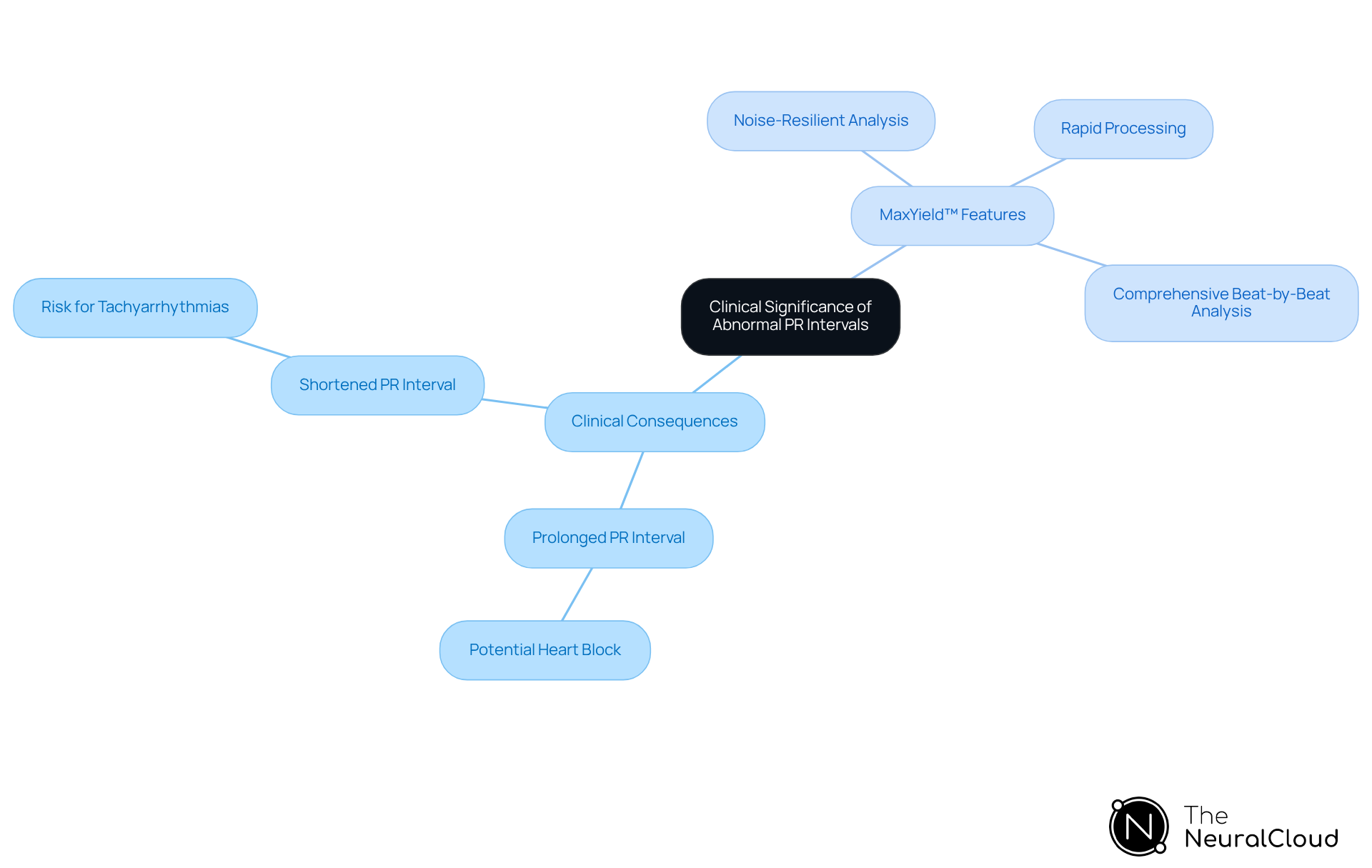Overview
The normal range for the ECG PR interval is defined as 120 to 200 milliseconds. This range is critical for assessing effective electrical conduction from the atria to the ventricles. Deviations from this range can indicate significant cardiac issues, such as:
- First-degree AV block
- Increased risks of atrial fibrillation
This highlights the necessity for health tech developers to create accurate ECG analysis tools. Such tools must reliably interpret these variations to support effective cardiac care.
Introduction
Understanding the intricacies of the ECG PR interval is essential for health tech developers aiming to improve cardiac health assessments. This important segment measures the duration for electrical signals to travel from the atria to the ventricles, acting as a critical indicator of heart function. With the increasing demand for precise ECG analysis tools, developers face a significant challenge: how can they ensure their technologies not only measure PR intervals effectively but also interpret deviations that may indicate serious health risks?
Define the PR Interval and Its Importance in ECG Analysis
The PR segment indicates the time taken for electrical signals to move from the atria to the ventricles, measured from the onset of the P wave to the start of the QRS complex on an ECG. This period is crucial as it reflects conduction time through the atrioventricular (AV) node. A normal PR duration, which is part of the ECG PR interval normal range of 120 to 200 milliseconds, suggests effective electrical conduction, while deviations can signal potential cardiac issues, such as first-degree atrioventricular block (AVB).
Research indicates that a PR duration of 190 milliseconds or longer is significantly linked to heightened risks of atrial fibrillation (AF) and heart failure hospitalization (HFH). For instance, individuals with a PR duration exceeding 200 milliseconds face a two-fold risk of developing AF and a three-fold risk of needing pacemaker implantation. These findings underscore the importance for health tech creators to develop ECG analysis tools that accurately interpret the PR segment, ensuring dependable cardiac health evaluations.
MaxYield™ offers advanced features that enhance ECG analysis. By integrating Neural Cloud Solutions' platform, developers can leverage advanced noise filtering and automated labeling to improve their tools' functionality. MaxYield™'s capability to examine distorted recordings and identify essential characteristics in each heartbeat enables a more accurate comprehension of PR duration variations. This offers a clearer benchmark for what defines a within the ECG PR interval normal range.
Furthermore, it is significant that the average intrinsic PR duration among patients is identified to be 185 ms, guiding the creation of effective ECG evaluation solutions. The combination of these features not only improves the accuracy of ECG readings but also enhances the overall efficiency of cardiac health assessments.

Identify the Normal Range for the PR Interval
The typical ECG PR interval normal range for PR duration lies between 120 to 200 milliseconds. This range may vary slightly based on individual patient factors, such as age and health status, but it should generally .
Developers must ensure that their ECG analysis platforms, particularly those utilizing Neural Cloud Solutions' advanced technology, can accurately assess and communicate this duration.
MaxYield™ offers exceptional capabilities in filtering out noise and managing physiological variability, which is essential for precise ECG interpretation.
By implementing algorithms that flag PR durations outside this standard range, health tech solutions can significantly enhance their diagnostic capabilities, effectively addressing the inefficiencies and challenges associated with traditional methods.

Explore Abnormal PR Interval Variations: Prolonged and Shortened
A prolonged PR duration, exceeding 200 milliseconds and falling outside the ECG PR interval normal range, may indicate first-degree AV block, where conduction through the AV node is delayed. Conversely, a shortened PR duration, less than 120 milliseconds, can suggest conditions such as Wolff-Parkinson-White syndrome, indicating that it falls outside the ECG PR interval normal range, which is typically longer. Given these variations, developers should incorporate features in their ECG analysis tools that not only measure the PR duration but also ensure that the ECG PR interval normal range is provided to give context for these changes. By leveraging advanced algorithms like those found in Neural Cloud Solutions' MaxYield™ platform, developers can significantly enhance ECG analysis.
Features of MaxYield™:
- Automated ECG Analysis: MaxYield™ excels in filtering noise and isolating critical waveforms, ensuring accurate readings.
- Beat-by-Beat Analysis: The platform delivers detailed insights into each heartbeat, allowing for precise identification of cardiac events.
- Enhanced Clinical Decision-Making: With comprehensive and clear ECG data, clinicians can make informed choices based on whether the ECG PR interval is within the normal range, as indicated by variations in PR durations.
Integrating MaxYield™ into not only enhances their overall effectiveness but also aids clinicians in delivering improved patient care. By providing accurate and contextual information, healthcare professionals can better interpret ECG data, leading to more effective treatment strategies.

Assess the Clinical Significance of Abnormal PR Intervals
Unusual PR durations can have substantial clinical consequences. A prolonged PR interval may necessitate further investigation for potential heart block, while a shortened interval could indicate a risk for tachyarrhythmias, especially when evaluating the ECG PR interval normal range. Health technology creators should guarantee that their ECG evaluation platforms, unlike others, not only identify these irregularities but also offer practical insights, such as suggestions for additional testing or monitoring.
MaxYield™ addresses these challenges with its advanced noise-resilient analysis, rapid processing capabilities, and beat-by-beat analysis of 200,000 heartbeats in less than 5 minutes. This platform enhances ECG analysis by providing healthcare professionals with timely and accurate data, allowing for informed clinical decisions. The features of MaxYield™ include:
- Noise-resilient analysis for clearer results
- Rapid processing to save time in critical situations
- Comprehensive beat-by-beat analysis for detailed insights
Ultimately, these advantages contribute to , as developers can enhance the overall utility of their platforms in clinical settings.

Conclusion
The ECG PR interval is a crucial marker in assessing cardiac health, reflecting the conduction time from the atria to the ventricles. Understanding the normal range of 120 to 200 milliseconds is essential for health tech developers, as deviations from this range can indicate serious cardiac conditions. By accurately interpreting the PR segment, developers can create tools that enhance the reliability of ECG evaluations, ultimately contributing to improved patient outcomes.
Key insights from the article underscore the significance of both prolonged and shortened PR intervals. Prolonged intervals may signal first-degree AV block, while shortened durations can indicate conditions such as Wolff-Parkinson-White syndrome. The integration of advanced technologies like MaxYield™ plays a vital role in enhancing ECG analysis by providing noise-resilient readings and detailed insights into each heartbeat. This ensures that clinicians can make informed decisions based on accurate data regarding the PR interval.
In conclusion, recognizing the importance of the PR interval within ECG analysis is imperative for health tech developers. By leveraging advanced platforms and algorithms, they can enhance diagnostic capabilities and ultimately improve patient care. As the field of cardiac health technology evolves, prioritizing accurate PR interval assessments will be key to addressing the complexities of heart health and ensuring timely interventions for patients at risk.
Frequently Asked Questions
What is the PR interval in an ECG?
The PR interval indicates the time taken for electrical signals to move from the atria to the ventricles, measured from the onset of the P wave to the start of the QRS complex on an ECG.
Why is the PR interval important?
The PR interval reflects conduction time through the atrioventricular (AV) node, which is crucial for effective electrical conduction in the heart. Abnormal PR durations can signal potential cardiac issues.
What is the normal range for the PR interval?
The normal range for the PR interval is between 120 to 200 milliseconds.
What are the risks associated with prolonged PR duration?
A PR duration of 190 milliseconds or longer is linked to heightened risks of atrial fibrillation (AF) and heart failure hospitalization (HFH). Specifically, a PR duration exceeding 200 milliseconds increases the risk of developing AF two-fold and the risk of needing pacemaker implantation three-fold.
How can ECG analysis tools be improved?
Health tech creators can develop ECG analysis tools that accurately interpret the PR segment by integrating advanced features such as noise filtering and automated labeling. This enhances the functionality and reliability of cardiac health evaluations.
What is the average intrinsic PR duration among patients?
The average intrinsic PR duration among patients is identified to be 185 milliseconds, which can guide the creation of effective ECG evaluation solutions.
How does MaxYield™ enhance ECG analysis?
MaxYield™ enhances ECG analysis by examining distorted recordings and identifying essential characteristics in each heartbeat, which improves the accuracy of ECG readings and the overall efficiency of cardiac health assessments.






